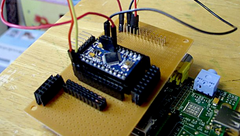Each development board or platform has their own strengths and weaknesses - and often to solve a problem you may be faced with using two to solve a problem. A common example of this is the combination of a Raspberry Pi and Arduino - which can give your projects excellent Internet connectivity along with a hardy method of controlling GPIOs, external hardware and more.
This has been demonstrated by Instructables member thegrandel who shows us how to make an add-on board for a Raspberry Pi that contains a small Arduino-compatible board along with matching GPIO headers to slot over the Pi. They have also demonstrated the software angle - including sending data from the Arduino back to the Pi and vice-versa using a bash script to control the Arduino via serial communications.

The PiLeven is an Arduino-compatible board based on the Arduino Uno, but with a few changes. Obviously it's a bit of a strange shape! The PiLeven fits right on top of a Raspberry Pi (either model B or B+) using the Raspberry Pi expansion headers.
The PiLeven also has a high-current switchmode power supply, so you can plug in anything from 7V to 18Vdc using the standard 2.1mm jack. The PiLeven can power the Raspberry Pi, so you don't need a regulated 5V USB connection anymore.
Serial communications on the PiLeven is linked through to the Raspberry Pi, so your Pi can upload new sketches straight to the PiLeven or send/receive data and commands. We've included level shifters so the 3.3V Pi can talk safely to the 5V PiLeven. And you can plug standard Arduino shields right into the PiLeven, giving your Raspberry Pi access to the huge range of shields already available. For more information about the PiLeven, including our tutorials - and to order yours today, visit the PiLeven webpage.











